Introduction
Navigating the complexities of caloric intake is essential for anyone aiming to manage their weight effectively. A clear understanding of daily caloric needs forms the foundation for successful weight loss, maintenance, or even gain. This article delves into the intricacies of calculating caloric requirements, exploring methods such as:
- The Mifflin-St Jeor equation
- The significance of Total Daily Energy Expenditure (TDEE)
It also highlights the importance of adjusting caloric intake based on personal goals and monitoring progress through various tracking strategies. By comprehensively addressing these elements, individuals can align their dietary habits with their health objectives, ultimately paving the way for informed and sustainable lifestyle choices.
1. Understanding Daily Caloric Needs
Establishing how many calories should I eat a day entails a thorough assessment of various factors, such as age, sex, mass, height, and activity level. On an average day, you may burn anywhere from 1,300 to 2,000 calories without any physical activity, which is important for figuring out how many calories should I eat a day. Central to this calculation is the Basal Metabolic Rate (BMR), which indicates the number of calories your body requires at rest to sustain essential physiological functions.
The Mifflin-St Jeor equation serves as a reliable method for calculating BMR:
- For men:
BMR = 10 × weight (kg) + 6.25 × height (cm) - 5 × age (years) + 5 - For women:
BMR = 10 × weight (kg) + 6.25 × height (cm) - 5 × age (years) - 161
After establishing your BMR, the next step is to determine your Total Daily Energy Expenditure (TDEE), which accounts for your activity level. This is accomplished by multiplying your BMR by the Physical Activity Level (PAL) factor:
- Sedentary (little or no exercise): BMR × 1.2
- Lightly active (light exercise/sports 1-3 days/week): BMR × 1.375
- Moderately active (moderate exercise/sports 3-5 days/week): BMR × 1.55
- Very active (hard exercise/sports 6-7 days a week): BMR × 1.725
- Super active (very hard exercise or physical job & exercise twice a day): BMR × 1.9
The resulting TDEE represents the number of calories you should consume daily to maintain your current condition. It is crucial to recognize that cutting too many calories may harm your health and make it harder to maintain loss, as noted by nutrition expert Katherine Marengo, LDN, R.D. Additionally, incorporating liquid calories from whole milk, smoothies, and high-calorie shakes can help boost energy consumption without feeling overly full.
Comprehending these calculations and strategies is crucial for an effective management plan. Moreover, research on Zepbound's typical reduction in mass outcomes offers understanding of how appropriate energy management can improve slimming efforts.
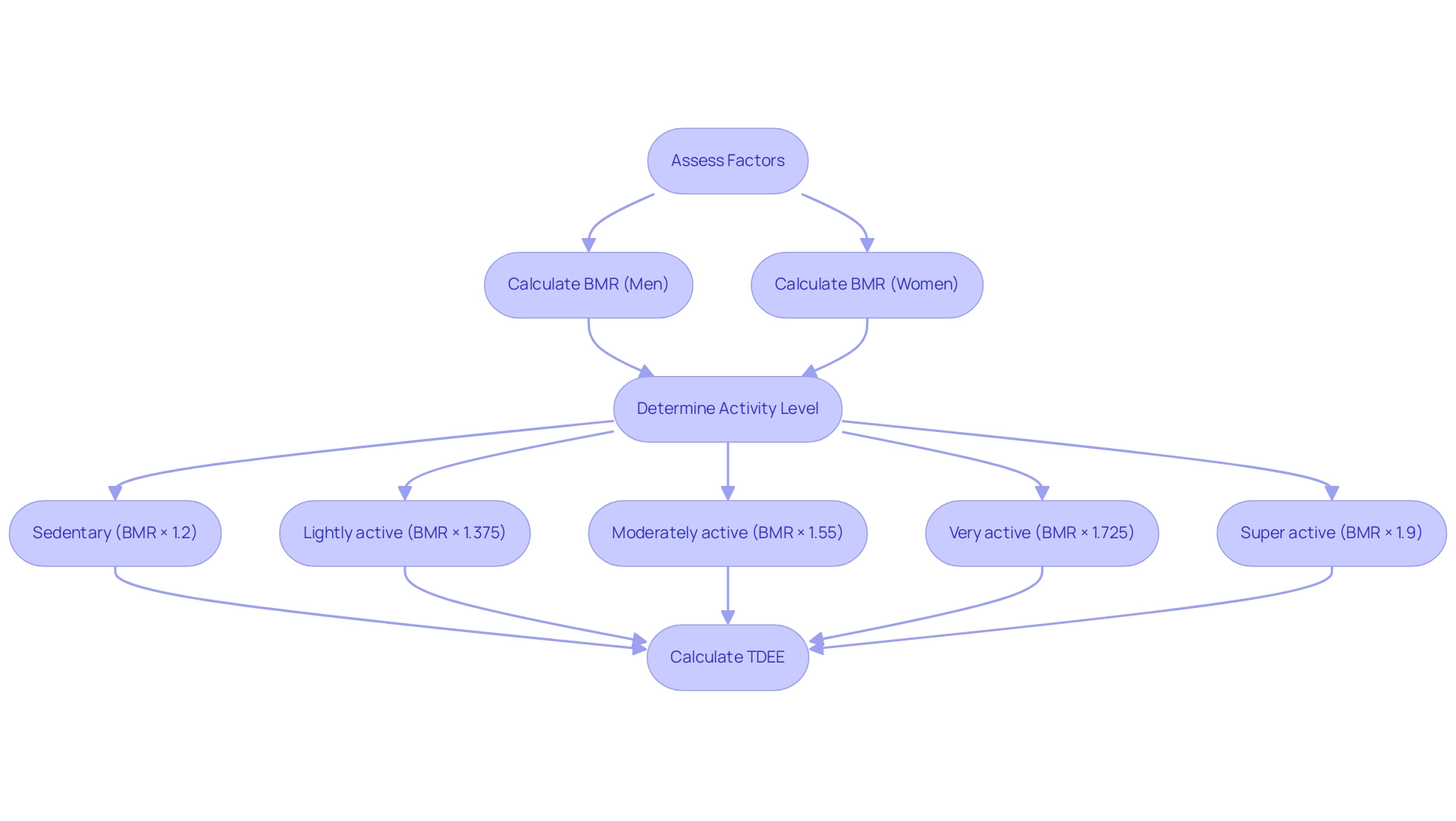
2. Step-by-Step Methods to Calculate Your Caloric Intake
To accurately calculate your caloric intake and support your weight loss journey, follow these systematic methods:
-
Using the Mifflin-St Jeor Equation: Start by determining your Basal Metabolic Rate (BMR) with the Mifflin-St Jeor equation, a reliable method for estimating daily energy requirements. It’s important to note that your resting metabolic rate (RMR) reduces approximately 0.01 kcal/min for every 1% increase in body fat, which can influence your energy requirements. Once you have your BMR, you can calculate how many calories should I eat a day by multiplying it by your Physical Activity Level (PAL) to find your Total Daily Energy Expenditure (TDEE).
-
Utilizing Online Calculators: A variety of online tools can streamline this process. By entering your age, mass, height, and activity level into a trusted online calculator, you can receive a customized estimate of your daily energy needs. In 2024, several of these calculators are recognized for their accuracy and ease of use, offering a valuable resource for health enthusiasts. As Anthony O'Reilly, GGR Performance Editor, states, "A very easy-to-use nutrition app. Sort of reminds me of MyFitnessPal before it started charging for every feature on the app."
-
Tracking Your Intake: For a tailored approach, maintain a food diary or utilize a nutrition app to track your caloric intake over a week. Nutrition apps can assist users in reaching calorie goals while effectively tracking health and fitness data. Begin by recording your mass at the start and end of this period. If your mass remains unchanged, the average number of calories consumed during this week can help determine how many calories should I eat a day to maintain your current weight. To accomplish shedding pounds, consider how many calories should I eat a day by decreasing your consumption by roughly 500 calories daily, which can promote a gradual reduction of around one pound each week.
-
Consulting a Nutritionist: For personalized guidance, seek the expertise of certified nutritionists at Awesome Health Club. These experts can offer personalized calculations and dietary suggestions suited to your individual health condition and fitness objectives, ensuring that your method of food consumption aligns with your reduction goals. They offer support in various areas, including meal planning, portion control, and strategies for managing specific dietary needs, such as diabetes or cardiovascular health.
Schedule your free consultation today to begin your journey towards effective management of your body with the assistance of our certified nutritionists. By utilizing these methods and leveraging the personalized support accessible through certified nutrition specialists, you can effectively ascertain your daily energy requirements and align your dietary habits with your weight loss goals.
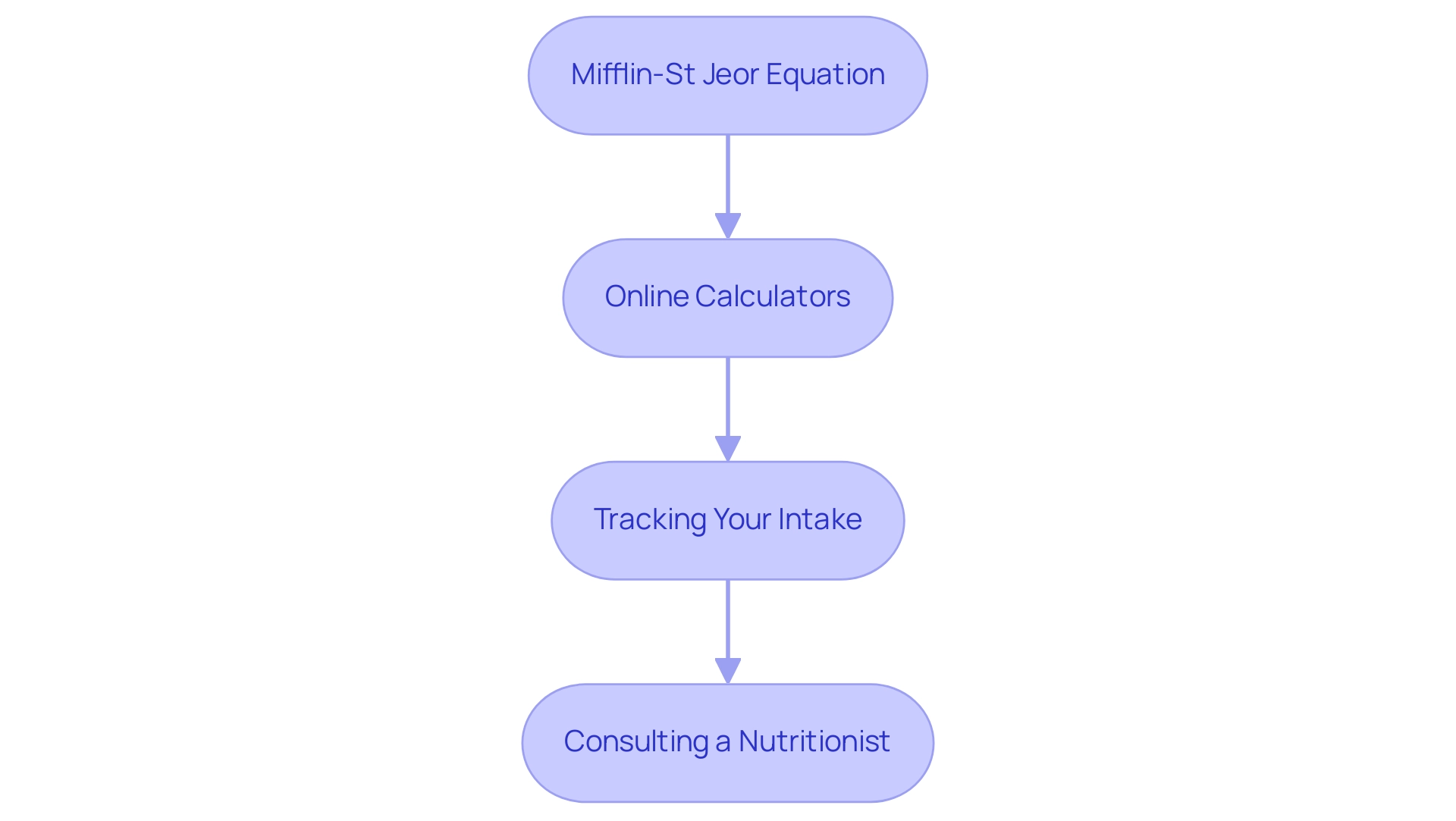
3. Adjusting Caloric Intake Based on Goals
To effectively adjust your caloric intake, consider the following guidelines:
-
For Weight Loss: To determine how many calories should I eat a day, establish a caloric deficit by consuming 500-1000 fewer calories than your Total Daily Energy Expenditure (TDEE). This method usually results in a secure reduction of around 1-2 pounds each week. Research indicates that merging decreased carbohydrate consumption with overall calorie limitation improves the effectiveness of fat loss methods, especially for individuals categorized as overweight or obese. As mentioned, "the combination of limiting carbohydrate and total calorie consumption may enhance the positive effects of decreasing BMI, body mass, and metabolic risk factors among overweight/obese individuals."
-
For Mass Increase: To encourage mass gain, raise your energy consumption by 250-500 calories above your TDEE. It is crucial to focus on nutrient-dense foods to ensure that increases are primarily from lean mass rather than excess fat. Current guidelines emphasize the importance of a balanced approach, with an average caloric surplus of 250-500 calories being recommended for muscle gain.
-
For Maintenance: If your aim is to sustain your current mass, continue to consume calories equivalent to your TDEE. Regularly monitor your mass and make adjustments as needed based on fluctuations in your activity level or metabolic rate to help you figure out how many calories should I eat a day.
-
Reevaluating Objectives: Regularly review your dietary requirements and overall aims, especially following substantial changes in mass or activity levels. This ongoing evaluation is essential to determine how many calories should I eat a day to ensure that your caloric consumption remains aligned with your objectives and to adapt to any shifts in your metabolic requirements.
Furthermore, research like that conducted by Trepanowski et al. in 2018 emphasizes the subtleties in managing body composition strategies, highlighting that while certain dietary modifications can be advantageous, the evidence remains varied concerning specific elements like dairy consumption and its impact on reducing body mass. For example, the research named 'Calcium and Dairy Consumption in Weight Reduction' investigated the connection between increased dairy servings and reduction in mass, discovering that low-fat dairy consumption was associated with reduced mass regain.
Thus, a personalized approach is recommended, especially considering the increasing total consumption of all three macronutrients in recent dietary trends.
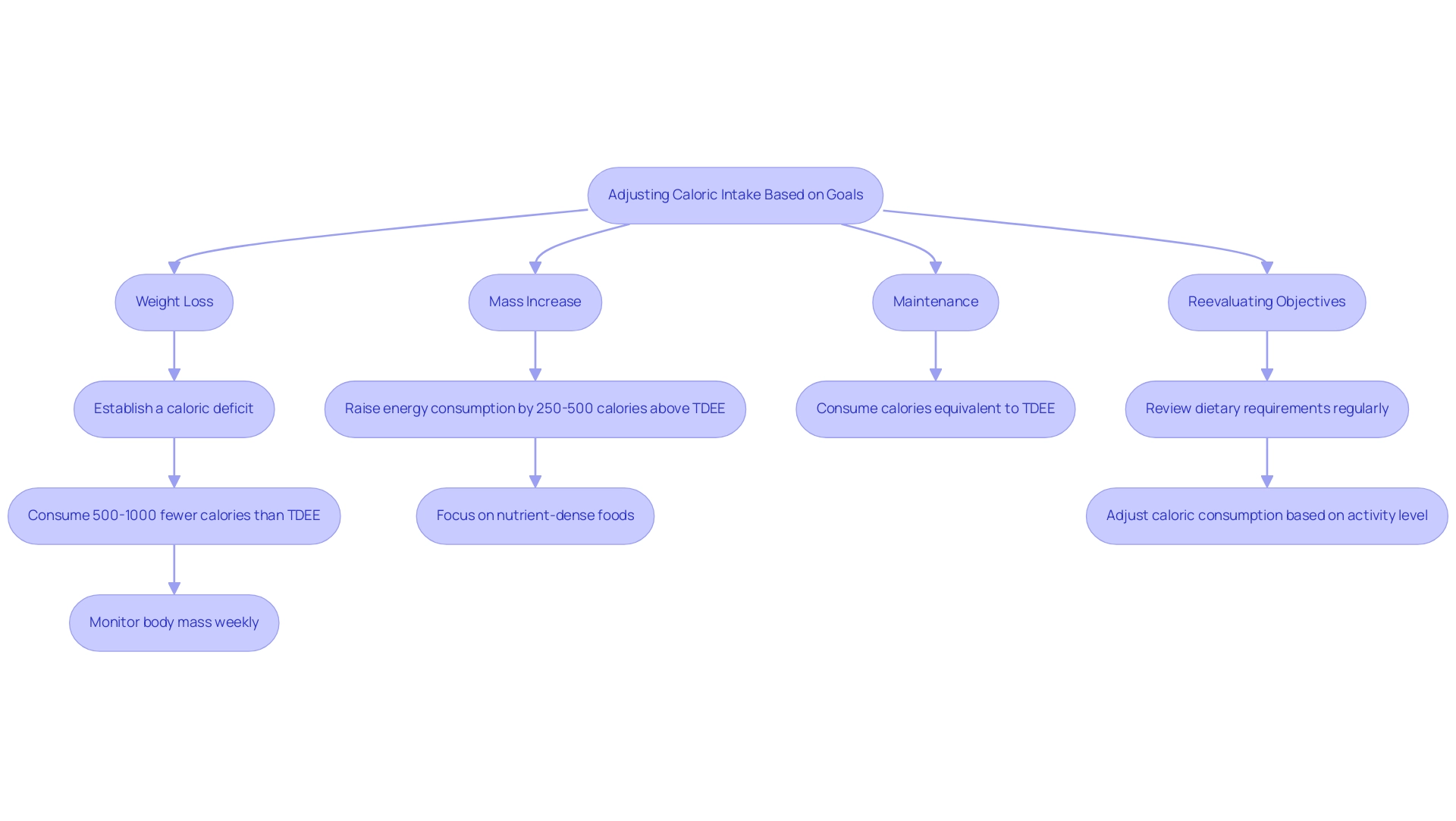
4. Monitoring and Tracking Your Progress
To effectively monitor and track your progress in a caloric deficit for losing pounds, consider the following best practices:
-
Utilize a Food Diary or App: Recording your daily food intake and exercise habits in a food diary or using a mobile app is crucial. This method not only helps you stay accountable but also enables you to identify patterns in your eating behavior. As noted by Trishita Deb, a market research and consulting expert, effective food tracking is essential in developing a successful dietary strategy. Given that global diets are lacking in recommended nutrients, with only 12% of the recommended amount of nuts and seeds consumed, tracking what you eat can help ensure you meet your nutritional needs.
-
Weigh Yourself Regularly: Consistency is key when monitoring your mass. Weigh yourself at the same time each week, ideally after waking up, to ensure precise tracking of your changes in mass. Regular weigh-ins provide critical feedback on your progress and help inform any necessary adjustments in your diet. The overall mean WEL score of 115.5, with a standard deviation of 29.9, emphasizes the importance of maintaining adherence to dietary plans for effective management of body mass.
Take Body Measurements: In addition to monitoring your weight, taking measurements of key areas such as your waist and hips can provide a more comprehensive view of your progress, particularly if you are engaging in strength training. This dual approach addresses the fact that body composition changes may not always reflect on the scale, yet can indicate positive progress.
-
Adjust Based on Data: Analyze the information you collect to understand how many calories should I eat a day and make informed modifications to your dietary intake and exercise routine. If you discover that your results are not meeting expectations, reassess your dietary calculations and activity levels. Research from Kaiser Permanente's Center for Health Research highlighted that participants who maintained daily food records lost approximately 13 pounds over six months, particularly emphasizing the importance of frequent diary entries and attendance at support sessions, which significantly contributed to their success.
By diligently monitoring your progress through these methods, you will be well-equipped to make informed dietary and fitness decisions, ultimately leading to successful management.
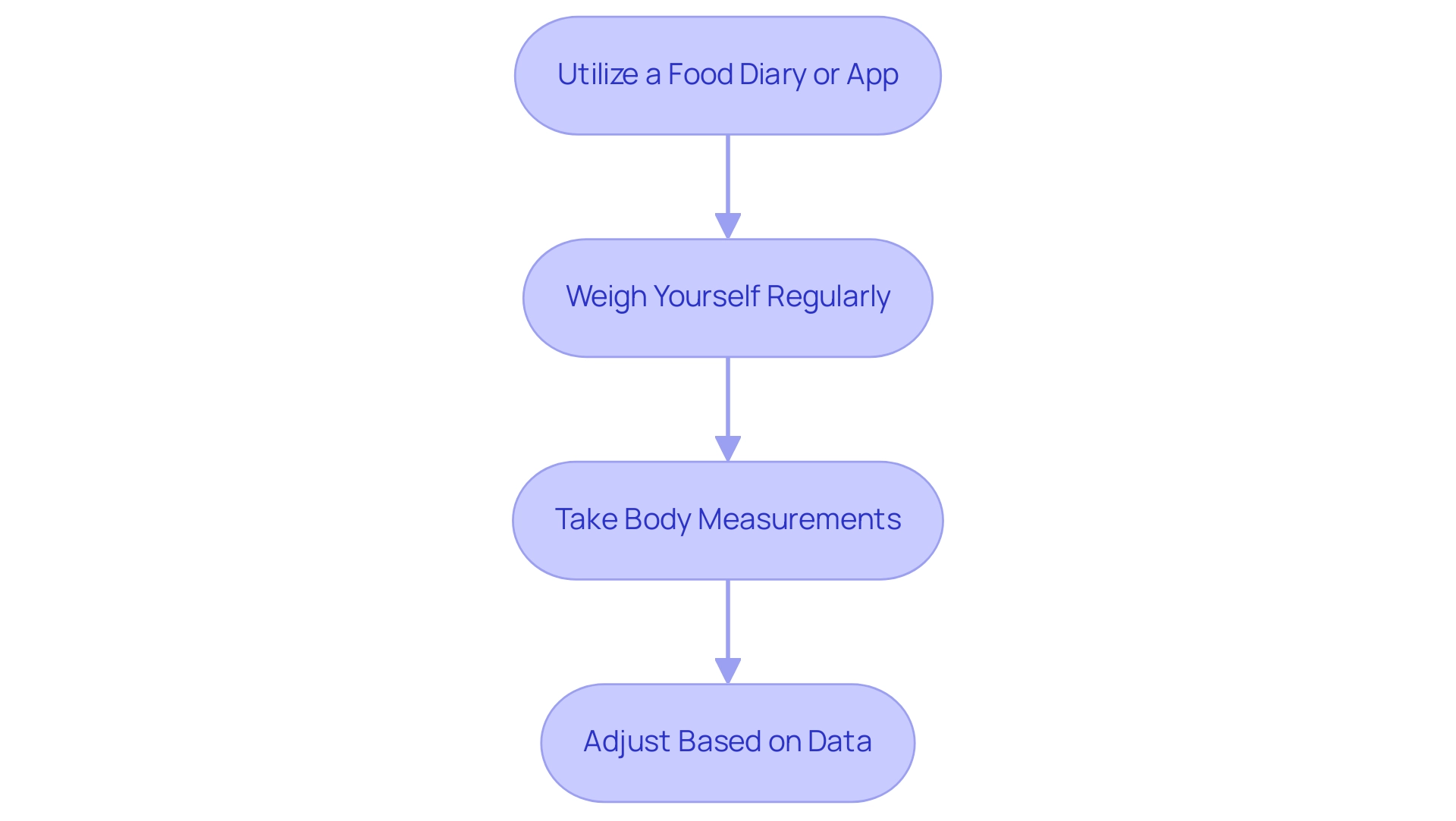
5. Understanding Macronutrient Ratios
To enhance energy consumption effectively, it is essential to consider the following macronutrient ratios tailored to specific health goals:
-
For Weight Loss: A commonly recommended ratio is 40% carbohydrates, 30% protein, and 30% fat. This distribution not only promotes satiety but also ensures sufficient protein consumption to preserve muscle mass during the weight loss process.
Furthermore, using the Daily Sugar Consumption Calculator can assist you in selecting food items with less than 8 grams of sugar per serving, significantly affecting overall caloric consumption and health results. As Albert states, 'If yes, then that's considered a good option and a healthier choice.'
-
For Muscle Gain: To aid in muscle repair and growth, a higher protein consumption is beneficial. A suggested ratio for this goal is 30% carbohydrates, 40% protein, and 30% fat.
-
For Maintenance: For those looking to maintain their weight, a balanced approach of 50% carbohydrates, 25% protein, and 25% fat can provide sufficient energy for daily activities while sustaining overall health.
-
Adjusting Ratios: It is crucial to adjust these ratios in accordance with individual preferences, dietary restrictions, and specific health needs.
Engaging with a nutritionist can offer tailored guidance that aligns with personal lifestyle choices. Additionally, the case study titled 'Macro Diet for Beginners' emphasizes that a macro diet corresponds with the Dietary Guidelines for Americans 2020–2025, suggesting that 45–65% of daily energy consumption should originate from carbs, 20–35% from fat, and 10–35% from protein.
To effectively reduce your sugar consumption, consider:
- Swapping sugary snacks for healthier options like fruits or nut
- Being a label detective to spot hidden sugars
- Limiting sugary drinks in favor of herbal tea or water with lemon
By comprehensively understanding and applying these macronutrient ratios, along with effective strategies for reducing sugar intake, you can figure out how many calories should I eat a day to ensure that your daily caloric intake is not only adequate but also conducive to your overall health and fitness objectives.
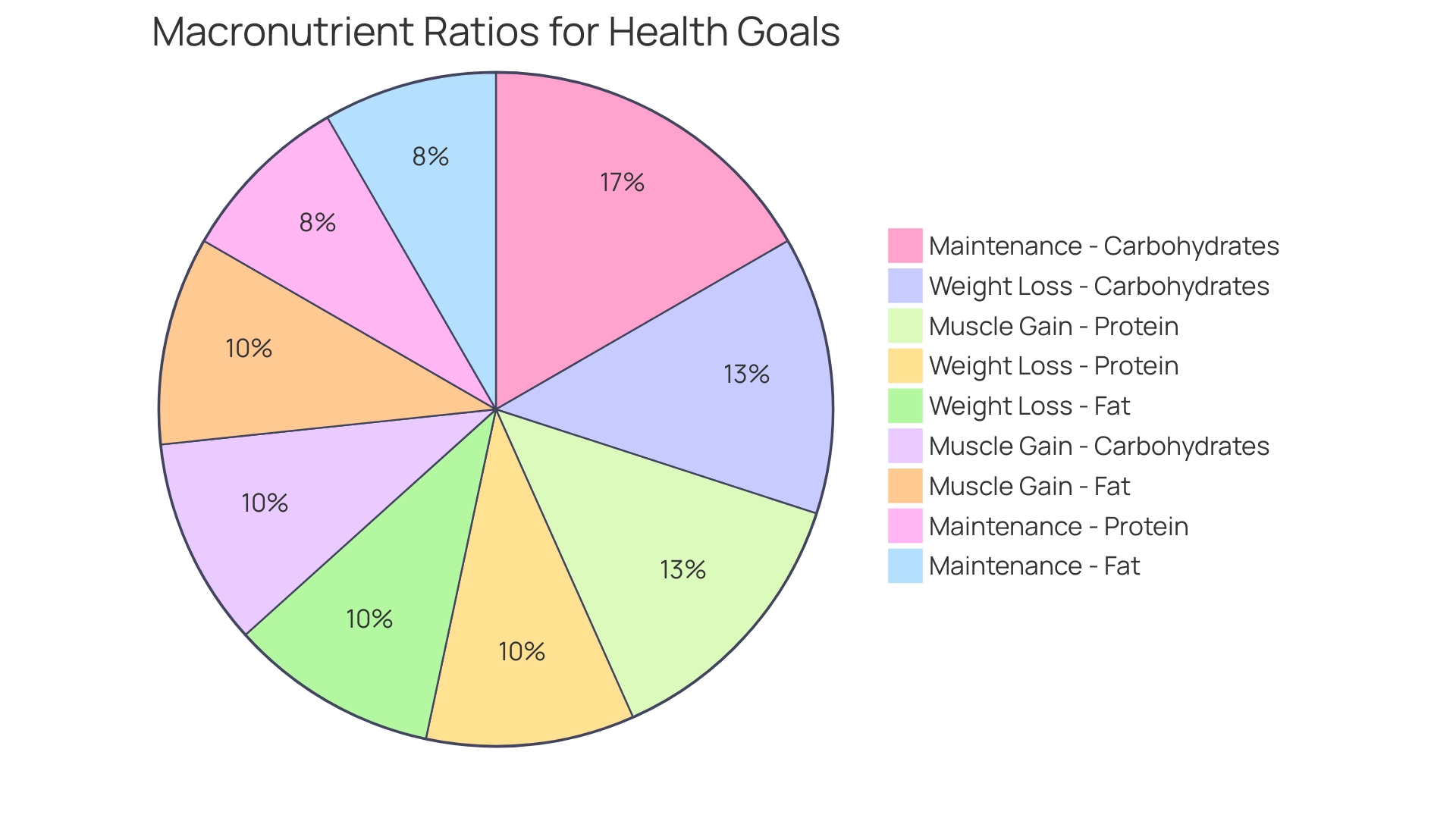
Conclusion
Understanding daily caloric needs is fundamental for anyone seeking to manage their weight effectively. By calculating the Basal Metabolic Rate (BMR) using the Mifflin-St Jeor equation and determining Total Daily Energy Expenditure (TDEE), individuals can establish a clear baseline for their caloric requirements.
This foundational knowledge empowers individuals to tailor their dietary habits according to their specific goals, whether it be weight loss, maintenance, or gain.
Adjusting caloric intake based on personal objectives is crucial. For weight loss, creating a caloric deficit can lead to safe and effective results, while those looking to gain weight should focus on a caloric surplus with nutrient-dense foods. Regularly reassessing caloric needs ensures that dietary strategies remain aligned with changing goals or activity levels. Moreover, monitoring progress through tracking methods fosters accountability and allows for informed adjustments based on individual responses.
Ultimately, a comprehensive understanding of caloric intake, along with macronutrient distribution, can enhance overall health and support sustainable lifestyle changes. By implementing these strategies, individuals can make informed dietary choices that not only help achieve their weight management goals but also promote long-term well-being. Prioritizing a balanced approach to nutrition is key to navigating the complexities of caloric intake effectively.




























